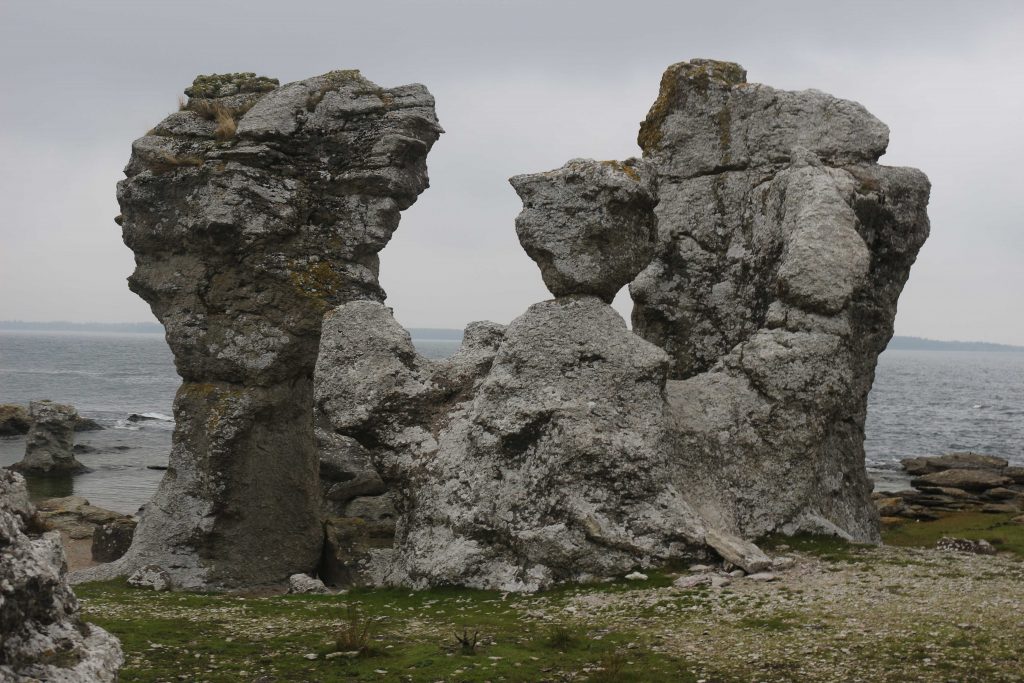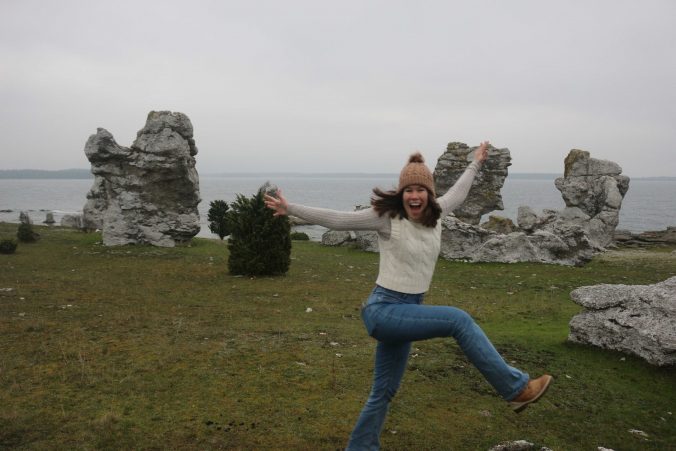Fossils are actually a little bit responsible for how I ended up studying Energy Transition at Campus Gotland. I was still in highschool, sitting in one of my environmental science classes, sleep deprived as ever – being an International Baccalaureate student – when my teacher posed the question to our class as to whether we know where some of Sweden’s most incredible fossils can be found. Sitting there, I wanted to make an effort to actively contribute to the discussion, and my memories drifted to a time when I was much younger, on a field
trip, deep in nature, squatting as I searched for fossils… on Gotland!
My answer was, of course, correct. Across this island in the Baltic Sea, rocks that indicate global extinctions and other prehistoric events are just abundant. Remembering my short class trip to Gotland as a mere 12-year old inspired me to spend the rest of my lesson looking up university possibilities on the island – of which there was actually just one… I was amazed to realise that not only does Campus Gotland offer some exciting programmes related to the environmental sciences field I was interested in, but the campus is even part of Uppsala
University, Sweden’s first and oldest university. There and then, I knew I wanted to study here.
I’m currently in my third, and last, year of studying Energy Transition – Sustainability and Leadership. I don’t study about fossils much, I almost forgot about my fascination towards them during the period between highschool and the start of my new life on Gotland. They have a way of reappearing in my life though. During an evening walk by the seaside near the university, I glanced down at my feet and happened to notice a stunning little fossil. Besides it lay another. And another. Once I squatted down to take a closer look, I couldn’t unsee the
beautiful fossilised bounty of the seaside.
During my occasional travels around Gotland, a must-have on my agenda is finding rauks – fascinating limestone land formations created by wave erosions during the course of Gotland’s geological history. One of my favourite Gotland facts that I learned during the Visby tours, which Uppsala University offers to new students every year, is that this island’s bedrock is formed of prehistoric, fossilised coral reefs, some of which withstood the course of crashing waves over time and remained standing as isolated land formations. These are the rauks, hard limestone rocks that contain fossilised remaints of the prehistoric reefs Gotland
was formed on.
Campus Gotland is located in an environment where winding down after class in a fossil paradise, and hiking to a rauk field, is all possible. I spent all my life living in capital cities where such was unimaginable, hence sharing my new home with such rich geological pieces of history fascinates me. I feel lucky to have started my university studies in a place that’s this peaceful, stunning, and so close to unique natural formations.
Many ask where I’m heading next, in June when my studies at Campus Gotland come to an end. In 20 years, I simply hope to imagine myself being knee-deep in fossils, with the same sparkle in my eyes as the one I’ve got that first evening during my seaside walk. I return to that spot often during my time in Visby, sometimes for a mere casual walk, other times with gloves in my pocket ready to keep my hands warm in case I pause to browse through the coast’s fossils.
If you would like to experience the serene calmness of walking through a rauk field, you’re welcomed to visit some of my favourite ones around Gotland:
- Lergrav: The first ever rauk field I’ve been to. Lergravsporten, a majestic rauk arch you can walk through, catches the rays of sunset if you visit the area in the evening.
- Holmhällar: This is where I stayed during my field trip when I was 12, but the place doesn’t only feel special to me. The area is abundant in fossils and a variety of captivating rauk formations.
- Snäckschimpansen: The closest rauk to Visby, found in Snäck. It’s exciting that I can walk here any time without having to plan a trip around it. I hear this rauk is a much newer formation than the ones you usually find around the island.
- Gamla hamn: The “postcard rauk”. This is the one you will find on most photographs of Gotland. It’s all the way on Fårö, so it’s a full day trip away. I thought it was a lot taller in real life!
- Digerhuvud: Also on Fårö, it’s Sweden’s largest rauk field. I spent a sunset here, and it was unlike anything I’ve experienced in terms of nature’s magic. The endless stretch of rauks along the coast were captivating.
- Lickershamn: This is just a half-hour ride from Visby. I was here on a rainy, misty day, and got to spend some truly peaceful moments around the rauks in this area.
Thank you for reading my little blog entry about how it’s party thanks to my fascination towards fossils that I discovered Campus Gotland. If I inspired you to go fossil-hunting or visit a rauk field, remember to brush up your knowledge prior to your trip about where it’s allowed to climb rauks or take fossils home with you, and don’t forget to leave nature the same way you found it.

I’m leaving you with a peculiar fact that always makes me smile a little: on Fårö, you’re not allowed to stack stones to make rock towers – moving stones away from their place is not permitted in efforts to conserve the natural landscape and the habitats of animals that dwell amongst the rocks.


Leave a Reply